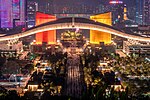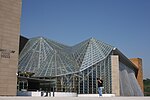Shenzhen (; ; Chinese: 深圳; pinyin: Shēnzhèn; Mandarin pronunciation: [ʂə́n.ʈʂə̂n] ) is a city and special economic zone on the east bank of the Pearl River estuary on the central coast of the southern Chinese province of Guangdong, bordering Hong Kong to the south, Dongguan to the north, and Huizhou to the northeast. With a population of 17.56 million in 2020, Shenzhen is the third most populous city by urban population in China after Shanghai and Beijing. Shenzhen is a global center in technology, research, manufacturing, business and economics, finance, tourism and transportation, and the Port of Shenzhen is the world's fourth busiest container port.Shenzhen roughly follows the administrative boundaries of Bao'an County, which was established in imperial times. The southern portion of Bao'an County became part of British Hong Kong after the Opium Wars, while the village of Shenzhen was on the border. Shenzhen railway station was the last stop on the Mainland Chinese section of the Kowloon–Canton Railway, and Shenzhen's economy grew and it became a city by 1979.
In the early 1980s, economic reforms introduced by Deng Xiaoping resulted in the city becoming the first special economic zone of China due to its close proximity to Hong Kong, attracting foreign direct investment and migrants searching for opportunities. In thirty years, the city's economy and population boomed and has since emerged as a hub for technology, international trade, and finance. It is the home to the Shenzhen Stock Exchange, one of the largest stock exchanges in the world by market capitalization and the Guangdong Free-Trade Zone. Shenzhen is ranked as an Alpha- (global first-tier) city by the Globalization and World Cities Research Network. Its nominal GDP has surpassed those of its neighboring cities of Guangzhou and Hong Kong and is now among those of the cities with the ten largest economies in the world. Shenzhen also has the eighth most competitive and largest financial center in the world, the seventh-most Fortune Global 500 headquarters of any city in the world, fifth-highest number of billionaires of any city in the world, the second largest number of skyscrapers of any city in the world, the 19th largest scientific research output of any city in the world, and several notable educational institutions, such as Shenzhen University, Southern University of Science and Technology, and Shenzhen Technology University.
The city is a leading global technology hub. In the media Shenzhen is sometimes called China's Silicon Valley. The city's entrepreneurial, innovative, and competitive-based culture has resulted in the city being home to numerous small manufacturers and software companies. Several of these firms have become large technology corporations, such as Huawei, Tencent, and DJI. As an important international city, Shenzhen hosts numerous national and international events every year, such as the 2011 Summer Universiade and the China Hi-Tech Fair.












